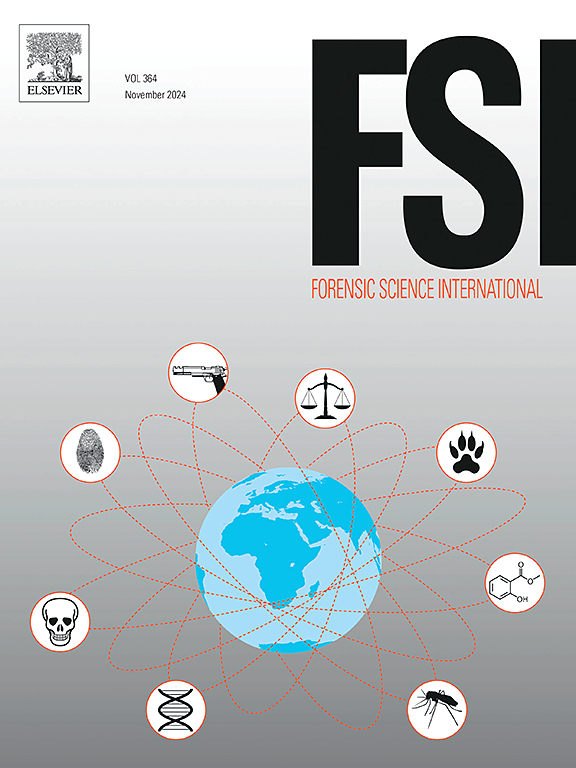Forensic metabolomics: Tracing cyanide-induced metabolic changes in fatalities
IF 2.2
3区 医学
Q1 MEDICINE, LEGAL
引用次数: 0
Abstract
Accurate detection of cyanide exposure is crucial, particularly in forensic science. However, cyanide's high volatility and potential biochemical conversions in biological samples pose challenges for direct detection, complicating the determination of cause of death. Identifying alternative cyanide metabolites as markers may mitigate false negatives and positives, extending the detection window in poisoning cases. This study aimed to evaluate metabolic changes induced by cyanide exposure in forensic cases using a multi-platform approach, including metabolomics and lipidomics analyses via liquid and gas chromatography coupled with high-resolution mass spectrometry. Results demonstrated clear discrimination between cyanide-exposed and control groups through OPLS-DA models. A total of 92 altered metabolites were identified in cyanide-exposed individuals compared to controls. Significant changes in metabolites primarily included glycerophospholipids (30.7 %), glycerolipids (14 %), fatty acyls (12.9 %), sphingolipids (8.0 %), amino acids and analogs (8.0 %), among others. Cyanide intoxication disrupted multiple metabolic pathways, including mitochondrial β-oxidation, acylcarnitine accumulation, a shift towards gluconeogenesis in amino acid metabolism, and ammonia homeostasis disturbance, affecting both ammonia recycling and the urea cycle. These pathways are essential for cellular energy production. The altered metabolic profiles provide insight into cyanide poisoning pathways, potentially aiding the development of new forensic diagnostic strategies. The area under the receiver operating characteristic curve was used to assess each model's predictive value. Findings suggest that metabolites such as phosphate and 3-hydroxybutyric acid could serve as diagnostic biomarkers in lethal cyanide poisoning cases. Future studies must evaluate these potential biomarkers' effectiveness in different fatal victim cohorts and validate the suggested panel through a targeted approach.
法医代谢组学:追踪氰化物引起的死亡代谢变化。
准确检测氰化物暴露是至关重要的,特别是在法医科学中。然而,氰化物的高挥发性和生物样品中潜在的生化转化为直接检测带来了挑战,使死因的确定复杂化。识别替代氰化物代谢物作为标记物可以减少假阴性和假阳性,延长中毒病例的检测窗口。本研究旨在利用多平台方法评估法医案例中氰化物暴露引起的代谢变化,包括代谢组学和脂质组学分析,通过液相和气相色谱结合高分辨率质谱分析。结果表明,通过OPLS-DA模型,氰化物暴露组和对照组之间存在明显的区别。与对照组相比,在氰化物暴露个体中共鉴定出92种改变的代谢物。代谢物的显著变化主要包括甘油磷脂(30.7 %)、甘油脂(14 %)、脂肪酰基(12.9 %)、鞘脂(8.0 %)、氨基酸和类似物(8.0 %)等。氰化物中毒破坏了多种代谢途径,包括线粒体β-氧化、酰基肉碱积累、氨基酸代谢向糖异生的转变和氨稳态紊乱,影响氨循环和尿素循环。这些途径对细胞能量的产生至关重要。改变的代谢谱提供了对氰化物中毒途径的深入了解,可能有助于新的法医诊断策略的发展。用受试者工作特征曲线下的面积来评估各模型的预测值。研究结果表明,磷酸盐和3-羟基丁酸等代谢物可作为致命氰化物中毒病例的诊断生物标志物。未来的研究必须评估这些潜在的生物标志物在不同致命受害者群体中的有效性,并通过有针对性的方法验证建议的小组。
本文章由计算机程序翻译,如有差异,请以英文原文为准。
求助全文
约1分钟内获得全文
求助全文
来源期刊

Forensic science international
医学-医学:法
CiteScore
5.00
自引率
9.10%
发文量
285
审稿时长
49 days
期刊介绍:
Forensic Science International is the flagship journal in the prestigious Forensic Science International family, publishing the most innovative, cutting-edge, and influential contributions across the forensic sciences. Fields include: forensic pathology and histochemistry, chemistry, biochemistry and toxicology, biology, serology, odontology, psychiatry, anthropology, digital forensics, the physical sciences, firearms, and document examination, as well as investigations of value to public health in its broadest sense, and the important marginal area where science and medicine interact with the law.
The journal publishes:
Case Reports
Commentaries
Letters to the Editor
Original Research Papers (Regular Papers)
Rapid Communications
Review Articles
Technical Notes.
 求助内容:
求助内容: 应助结果提醒方式:
应助结果提醒方式:


